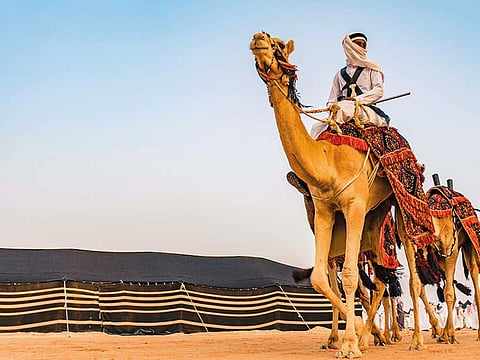The coveted camel honoured at Saudi festival
While historically Saudis relied heavily on camels for survival the creatures remain relevant today

Manama: What is it about camels that makes these “heritage” animals so relevant in modern times that a huge, lucrative and culture-filled festival is dedicated to them annually in Saudi Arabia?
Why should camels, the authentic symbol of the desert lifestyle of the people of the Arabian Peninsula, be celebrated amid ultra-modernism, impressive skyscrapers and tantalising buildings?
The organisers of the King Abdul Aziz Camel Festival are familiar with such questions and have their answers ready.
“Historically camels, one of God’s gifts to ease the tough conditions of desert life, were connected to Arabs and their way of life. Today, this fact remains valid. Camels are treasured for their special and unique characteristics. They may no longer be the main source of transportation, but they do remain loyal friends, reliable workers and an important food resource.
Today despite modern urbanisation, camels remain a great source of pride not only for camel breeders but all Arabs, who recognise camels as icons of Arab heritage, life and economy.”
The King Abdul Aziz Festival Camel Competition, often known as Miss Camel, this year is a new celebration of the past and of the present time and organisers promptly dismiss claims the festival is merely a celebration of the past and is not connected with present times.
“It is steeped in traditions of which we are proud, but it is also forward-thinking in its approach. The event also pushes the boundaries of technology and creativity to offer a one-of-a-kind fun-filled festival attracting fans from around the globe,” they said.
“At the heart of the festival is, of course, the much-loved and celebrated camel, reflecting the uniting role it has played for the Saudi Kingdom and the Gulf throughout history.
Known as ‘the ship of the desert’ – over many centuries and even today camels have become such an integral part of day-to-day life that they have formed part of the region’s personality and pride. Important in every pillar of society – economically, politically and culturally – camels are mentioned and prised throughout ancient religious texts and poetry. They are a source of meat, milk, leather and transport. A trading pillar in the Arab world, they have always been a renewable economic resource. Such attributes make them an essential part of the region’s growth, while reinforcing ties with tradition.”
Held from January 1 to February 1 in the southern desert terrains of Al Dahna, 120km from the capital Riyadh, the annual historic heritage festival founded in 1999 as a competition for the most beautiful camel will give away over 215 million Saudi Riyals in prize money, thanks mainly to the efforts of custodians King Salman bin Abdul Aziz Al Saud and Crown Price and Deputy Prime Minister and General supervisor of the camel club, Mohammad Bin Salman Bin Abdul Aziz.
The month-long festival, one of the biggest national celebrations of its kind in the world, includes initiatives to raise awareness, promote national pride, and celebrate core regional cultural and heritage practices in Saudi Arabia and across the Gulf Cooperation Council, the loose alliance that also comprises Bahrain, Kuwait, Oman, Qatar and the United Arab Emirates.
According to organisers, King Abdul Aziz Camel Festival 2018 will celebrate camels through an eclectic mix of traditional events, competitions and heritage-focused activities, including new and innovative activations.
Showcasing the camel’s amazing obedience skills, this competition looks at various components of a camel’s behaviour and sounds including its ability to carry a heavy load to its sense of yearning.
Looking at different factors such as the effect that various calling sounds and tones have on the animal’s response will determine the best-behaved camel in the desert.
For the Camel Beauty Contest, organisers have drawn up six colour-based camel categories - Al Majahim (Black Camels), Al Wedhah (white camels), Al Sheal (yellow camels), Al Suffur (yellow camels with black hump peak), Al Sheqah (reddish white camels) and Al Hommor (red camels with white front legs).
Each of the colour-based camels will take part in two parades, with four types of parades in all.
In the three age-based categories, standards of beauty are judged based on characteristics from the bridge of the nose, to the archangel, the hock, and the hump.
The festival also offers a series of Camel Hair Art and Sand Art Workshops aim to build the connection between heritage and culture of the desert.
Visitors learn the secrets behind camel hair weaving and are shown how useful it can be.
This year’s edition includes a special exhibition explores the history of camels in Saudi Arabia, including their mentions in religious texts, mummification, role as the ‘ship of the desert’ and the relationship with humans.
The Heritage Market showcases many aspects of Saudi history, heritage and culture.
Stalls offer traditional leather, perfumes, spices, tents, handicraft, tapestries, and traditional food and decorations.
Sign up for the Daily Briefing
Get the latest news and updates straight to your inbox



